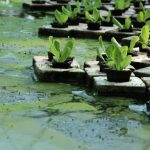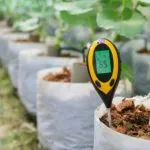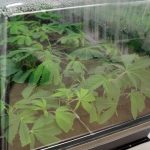Are you battling persistent algae in your hydroponic system? Do you desire a solution that is effective, yet won’t harm your plants in the process? Look no further; we’re about to reveal an unlikely hero – hydrogen peroxide. Yes, you heard right! Using hydrogen peroxide to kill algae in hydroponics has become a go-to technique for many green thumbs and commercial growers alike.
Hydrogen peroxide, known scientifically as H2O2, is not only effective against algae but also provides numerous benefits to the plants growing in your hydroponic system. Typically used as an antiseptic or bleach, this robust compound reveals its multifaceted nature when introduced into a hydroponics environment. It effectively combats algae while promoting healthier root systems and aiding nutrient absorption.

This article will serve as your comprehensive guide on leveraging the power of hydrogen peroxide to maintain an algae-free and thriving hydroponic system. We’ll take you through everything from the science behind hydrogen peroxide’s effectiveness against algae, how to correctly apply it in various setups, safety guidelines to keep in mind, and so much more. By the end of this post, you’ll be well-equipped with knowledge that can revolutionize your approach towards maintaining optimal health in your hydroponics ecosystem.
- Understanding Algae Growth in Hydroponics
- The Science Behind Hydrogen Peroxide Algae Treatment
- Benefits of Using Hydrogen Peroxide To Kill Algae in Hydroponics
- Choosing the Right Type and Concentration of Hydrogen Peroxide
- Proper Application Techniques
- Safety Precautions when Using Hydrogen Peroxide for Algae Control
- Impact on Hydroponic Plant Growth
- FAQs
Understanding Algae Growth in Hydroponics
Hydroponic systems, while advantageous in many ways, can be the perfect breeding ground for algae growth if not properly managed. To effectively combat and control algae, we must first understand their life cycle, how they thrive in hydroponic environments, common types encountered in hydroponics, and the impact they have on plant health and system efficiency.
How Algae Thrives in Hydroponic Systems
Algae are photosynthetic organisms that require light, water, and nutrients to grow—conditions readily available in a typical hydroponic setup. With exposure to light (natural or artificial) and access to nutrient-rich water used for plants’ growth, these microscopic organisms can proliferate rapidly.
Algae spores are omnipresent—they’re carried by air currents or might already be present on the surfaces within the growing area. Once they find favorable conditions (light, moisture, nutrients), they start multiplying rapidly. They form green or brown films on top of growth media, reservoir tops or even within nutrient solutions.
Common Types of Algae Encountered in Hydroponics
There are several types of algae that could pose problems in your hydroponic system. The most common include:
- Green Algae: This is the most frequently encountered type as it quickly spreads across wet surfaces exposed to light.
- Blue-Green Algae (Cyanobacteria): Even though it’s actually a bacteria, its behavior mirrors that of algae. It forms dense mats on water surfaces and can produce toxins harmful to both plants and humans.
- Brown Algae: Brown algae is often found clinging to dark corners of tanks or tubes where nutrients accumulate but light penetration is limited.
Impact of Algae on Plant Health and System Efficiency
The overgrowth of algae in a hydroponic system presents two main issues: competition with plants for resources and potential blockage of irrigation systems.
Competition for Resources: Algal bloom competes with plants for essential nutrients like nitrogen and phosphorus. These are necessary elements for plant development and by consuming them; algae inhibit the proper growth of your crops.
System Disruption: As algae multiply rapidly under suitable conditions, they may cause blockages inside tubing or emitters used for nutrient delivery. This disrupts water flow leading to uneven distribution among plants which could eventually affect overall yield quality.
Moreover, if unchecked over time, some types of algae can deplete dissolved oxygen levels during night-time respiration which can stress root systems causing overall weakening or disease susceptibility among your plants.
Understanding this balance between maintaining an ideal environment for your crops without encouraging algal growth is key to running a healthy and efficient hydroponic system. In a separate article, we give you many ways of how to stop algae in hydroponics, one of which is to use hydrogen peroxide.
The Science Behind Hydrogen Peroxide Algae Treatment
Hydrogen peroxide is a versatile and powerful compound that has been used for numerous purposes, from cleaning wounds to bleaching hair. But its potential goes beyond these traditional uses. Particularly in the world of hydroponics, hydrogen peroxide can be an effective solution for combatting algae growth. Let’s unlock the science behind how hydrogen peroxide kills algae.
How Does Hydrogen Peroxide Kill Algae?
The answer lies in its potent chemical structure. Hydrogen peroxide (H2O2) is essentially water (H2O) with an extra oxygen atom. This makes it highly reactive, as that extra oxygen atom is unstable and eager to bond with other molecules or break down into water and oxygen.
When applied to algae, this unstable compound releases its extra oxygen atom after coming into contact with the cell structures of the algae. The released oxygen wreaks havoc on the cellular level by breaking down the essential components of the algal cells, including proteins and DNA, thereby killing them.
Even at low concentrations, hydrogen peroxide is lethal for many algae types due to their relatively simple and often single-celled structures which are unable to withstand such oxidative stress.
Impact of Oxygen Release on Algae Cellular Respiration
The power of hydrogen peroxide isn’t solely in its ability to break down algal cells; it also disrupts their cellular respiration process. During cellular respiration, organisms like algae convert nutrients into usable energy with the help of oxygen – a process known as oxidation.
When hydrogen peroxide breaks down inside or around an algal cell, it produces not just water but free oxygen atoms as well. These free atoms can react quickly with various cellular components, leading to what scientists call oxidative stress.
This sudden influx of additional oxygen atoms overloads the controlled oxidation process during respiration and leads to uncontrolled reactions within the cell. As a result, cellular functions are disrupted and eventually lead to cell death.
How Long Does It Take For Hydrogen Peroxide To Kill Algae?
It depends on multiple factors such as concentration of hydrogen peroxide used, type and maturity stage of the algae involved. However, generally speaking, effects can typically be seen within hours of application as this potent compound works quickly once it comes into contact with algal cells.
Benefits of Using Hydrogen Peroxide To Kill Algae in Hydroponics
Hydrogen peroxide is a powerful ally in the fight against algae in hydroponic systems. This versatile substance offers a range of benefits, from its non-toxic nature to its compatibility with various systems and cost-effectiveness.
Non-Toxic Nature Compared to Chemical Alternatives
Unlike many chemical alternatives used for combating algae, hydrogen peroxide (H2O2) is relatively non-toxic. It decomposes into water (H2O) and oxygen (O2), both vital elements for plant growth. This decomposition not only makes it safer for your plants but also contributes to their overall health by providing supplemental oxygen. In contrast, most chemical algicides can have significant residual toxicity, which might harm your plants or disrupt the balance of nutrients in your system.
Compatibility with Various Hydroponic Systems
Another significant advantage of hydrogen peroxide is its broad compatibility with various hydroponic systems – it works equally well in Deep Water Culture (DWC), Nutrient Film Technique (NFT), Aeroponics, and other types of hydroponics setups. Its ability to dissolve quickly into water ensures that it spreads efficiently throughout the system, effectively targeting algae without damaging the plants.
Cost-Effectiveness and Availability
Hydrogen peroxide offers a cost-effective solution for controlling algae in hydroponic gardening. It’s generally cheaper than specialized algicides or other chemical solutions. Also, the fact that it decomposes into beneficial elements means you get added value beyond just algae control – such as enhancing root health by increasing oxygen levels. Hydrogen peroxide is readily available at drugstores, supermarkets, or online platforms, which enhances its appeal as an affordable and accessible option for maintaining healthy and productive hydroponic systems.
Choosing the Right Type and Concentration of Hydrogen Peroxide
Hydrogen Peroxide is a potent compound that can aid in controlling and eliminating algae growth in hydroponic systems. However, it’s crucial to select the appropriate type and concentration of hydrogen peroxide for your specific situation to ensure effective use while minimizing potential harm to your plants.
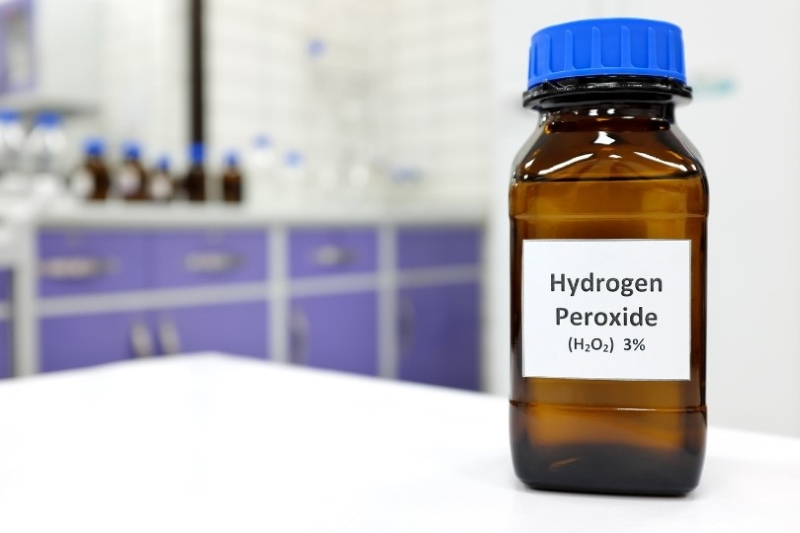
Overview of Different Types (Concentrations) Available Commercially
There are several concentrations of hydrogen peroxide available commercially, including 3%, 6%, 12%, 30%, and 35%. The concentration indicates how much pure hydrogen peroxide is present in the solution, with the balance being water. For instance, a bottle labeled as ‘3% Hydrogen Peroxide’ contains 3% pure hydrogen peroxide and 97% water.
The three most common types used in hydroponics are:
- 3% Hydrogen Peroxide: This is an easily accessible over-the-counter product, in diluted form, usually found in drug stores. It’s safe to add directly to the water in your reservoir. Manufacturers usually add stabilizers to it.
- 8 – 12% Hydrogen Peroxide: More concentrated than the previous one, it is diluted from 35% food-grade H2O2 so that it can be shipped commercially. This must be further diluted before use.
- 35% Food Grade Hydrogen Peroxide: The most potent and pure option available, this higher concentration should be used with extreme caution due to its potential danger if misused. It can be highly effective against severe algae problems when used correctly. Stabilizers are not needed to keep it stable but it is not easy to ship, so manufacturers dilute food grade 35% H2O2 to 8% or 12% first.
Viva Doria Hydrogen Peroxide 12 Percent Aqueous Solution – Food Grade, 16 Fl Oz
- Purest form of Hydrogen Peroxide: Food grade, highly purified, suitable for human consumption when properly diluted.
- High-Quality: Exceeds customer expectations with high quality sourcing.
- Multiple Uses: Used in hydroponics to kill algae, as a natural disinfectant, for water purification, as a mouthwash, and in various health and wellness applications. Also utilized in the food industry.
- No Harmful Substances: Free from stabilizers, additives or impurities.
How Much Hydrogen Peroxide Per Gallon Of Water For Hydroponics?
Deciding on the right amount of hydrogen peroxide for hydroponics involves considering two critical factors: system size and severity of algal infestation.
You should never fill your reservoir with a very concentrated hydrogen peroxide solution if you don’t want to damage or kill your plants. One part of the 35% concentrate should always be mixed with eleven parts of water before use. This dilution results in a 3% concentration. If you have access to distilled water, use it instead of tap water.
System Size Larger systems will require more hydrogen peroxide than smaller ones. Generally speaking, you’ll need around two to three milliliters of food-grade (35%) hydrogen peroxide for each gallon of water in your system. That’s about 2-3 teaspoons if you’re using 3% H2O2. Therefore, first estimate how many gallons of nutrient water is present in the reservoir and then add the appropriate amount of H2O2.
Severity Of Algae Problem For minor algae issues or preventative measures, lower concentrations (around a ratio of 3%) can be adequate. However, severe infestations might necessitate a higher concentration up to even 12%.
While there is no exact answer due to variations based on factors such as system size and level of infestation, it’s generally recommended to start with lower concentrations and gradually increase if necessary. Always monitor your plants closely after application to ensure they’re not adversely affected by the treatment.
Proper Application Techniques
Unlocking the power of hydrogen peroxide for algae control in hydroponics is all about proper application. There are a few vital considerations when using hydrogen peroxide in hydroponics, including step-by-step safe application, optimal timing, and dosage calculation. Let’s explore these topics in more depth.
Step-by-Step Guide for Safely Adding Hydrogen Peroxide to Hydroponic Systems
When dealing with something as potent as hydrogen peroxide (H2O2), it’s crucial to follow a step-by-step guide to avoid adverse effects due to incorrect usage.
- Wear Protective Clothing: As H2O2 can irritate the skin and eyes, always put on gloves and eyewear before handling a high concentration mix.
- Measure Water Volume: You need to know your system’s water volume because this will determine the amount of H2O2 you’ll use.
- Calculate Dosage: Based on your system’s water volume, calculate the necessary dosage of hydrogen peroxide. The standard concentration is generally around 3% H2O2 solution.
- Add H2O2 Solution: Mix the calculated dosage into a container filled with some water from your system first before adding it back to avoid shocking plants and beneficial microorganisms.
- Monitor Your System: Observe your plants closely after adding the mixture for any adverse reactions.
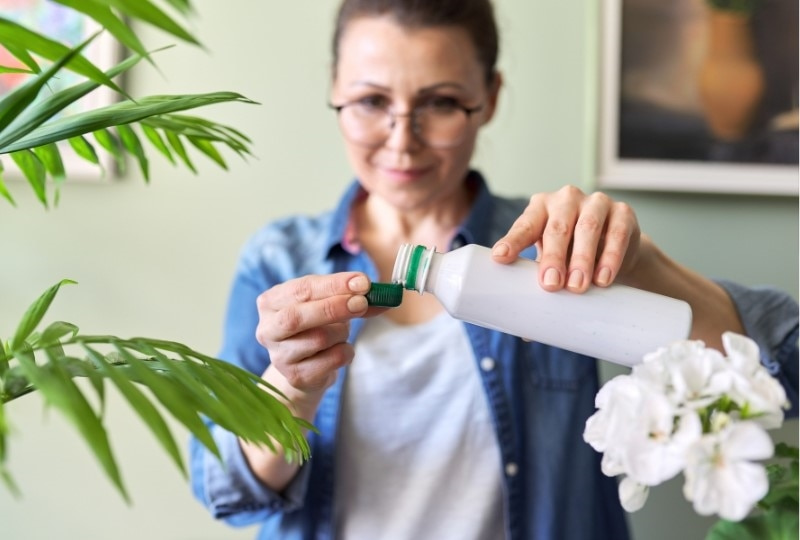
How Often To Add Hydrogen Peroxide To Hydroponics?
Ensuring that you apply hydrogen peroxide at the right time can optimize its effectiveness while minimizing potential harm. Generally, applying once every two weeks should be enough unless there’s an ongoing algae issue, in which case you might need weekly applications until under control.
Calculating Dosage Based on Water Volume and Desired Results
Determining the correct dosage based on your system’s water volume and desired results is essential when using too much H2O2 in hydroponics could harm beneficial organisms and damage plant roots.
The typical recommendation is a ratio of about 3ml of 3% H2O2 solution per 1 liter of water in your system for preventative measures against algae blooms, but this may vary depending on specific circumstances like plant sensitivity or the severity of an existing algae problem.
Related: Consider using hydrogen peroxide in a hydroponic system when it’s time to clean all the components. We show you how.
Safety Precautions when Using Hydrogen Peroxide for Algae Control
Hydrogen peroxide is a powerful tool in the battle against algae in hydroponic systems. However, its potent properties can also present risks if not used cautiously and correctly. This section is dedicated to discussing important safety precautions you should follow while handling or storing hydrogen peroxide.
Protective Gear
The first line of defense when dealing with hydrogen peroxide is wearing appropriate protective gear. Hydrogen peroxide, especially at higher concentrations, can be harmful to your skin, eyes, and other body parts upon contact.
Always make sure to wear gloves when handling hydrogen peroxide as it can cause chemical burns or skin irritation if spilled on the skin. For complete protection, consider using rubber or nitrile gloves that offer superior resistance to chemicals.
Additionally, goggles are necessary for protecting your eyes from any accidental splashes. Hydrogen peroxide can cause severe eye damage or even blindness.
To protect your clothing and prevent potential skin contact, a lab coat or waterproof apron could be beneficial during application. Remember that safety comes first when working with chemicals like hydrogen peroxide.
Storing Hydrogen Peroxide: Maximizing Shelf Life and Safety
Proper storage of hydrogen peroxide is just as crucial as safely handling it. If stored improperly, it has a risk of decomposing rapidly which could result in a dangerous situation due to the release of oxygen gas.
When storing hydrogen peroxide, keep it in a cool and dark place – sunlight exposure can degrade it over time. It’s best stored in its original container with tight sealing to prevent leakage and contamination.
As for its shelf life, depending on the concentration level and storage conditions, unopened bottles of hydrogen peroxide could remain stable for many months up to 3 years. However, once opened it will start degrading slowly due its exposure to air; so usage within six months is recommended for optimum effectiveness.
In conclusion, although hydrogen peroxide provides an effective solution against algae in hydroponic systems; proper handling procedures including using protective gear; along with careful storage considerations need to be adhered to ensure your safety.
Impact on Hydroponic Plant Growth
Hydrogen peroxide’s role in hydroponics is a double-edged sword. On one hand, it can be an effective solution to control and kill algae that often hampers plant growth. On the other hand, if not used correctly, it can potentially harm your plants or the beneficial microorganisms living in your hydroponic system.
Risks and Precautions with Hydrogen Peroxide Use
Using hydrogen peroxide comes with potential risks that need careful management for optimum plant growth. An overdose of hydrogen peroxide can not only kill harmful algae but could also adversely affect the health of your plants and the beneficial bacteria that help break down organic matter in the growing medium.
To avoid this, it’s important to use hydrogen peroxide at the right dosage and frequency. A general rule is to start with a lower concentration (around 3%) and carefully observe how your plants respond before gradually increasing its use.
Additionally, remember that light breaks down hydrogen peroxide into water and oxygen rapidly. To prevent degradation and maintain effectiveness, store it out of direct sunlight and add it to your hydroponic system during periods when lights are off or at the minimum level.
The Oxygen Content Factor
One unique benefit of using hydrogen peroxide is its ability to increase the oxygen content in a hydroponics system due to its composition – two parts hydrogen and two parts oxygen (H2O2). When added to water, it breaks down into water (H2O) and an extra oxygen molecule (O), thereby enriching the water with additional oxygen.
This extra oxygen can stimulate root development as well as enhance nutrient uptake leading to healthier, more vigorous plant growth. However, ensure you balance this advantage against potential risks through careful usage for successful implementation of hydrogen peroxide in your hydroponics system.



